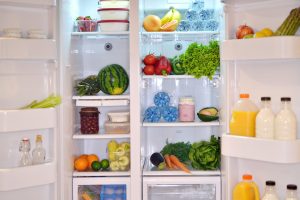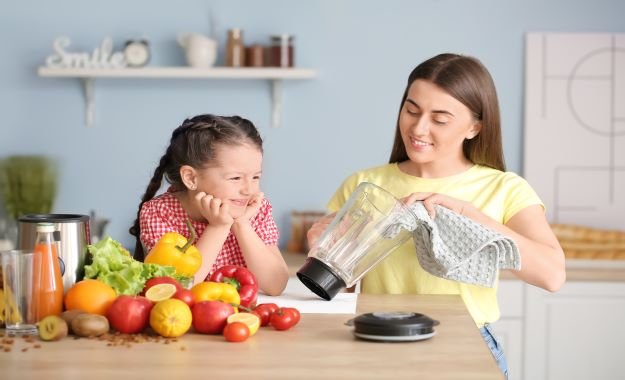If the kitchen is the hub of the home, the refrigerator is more like a sun at the center of the universe, orbited by family members. It is where most meals begin, an essential appliance that can also have a major effect on the food choices you make. And while you may not realize it, investing some time in organizing your refrigerator can take some stress out of the busy back-to-school season.

The everyday act of opening the refrigerator door can lead to a decision that may affect our day in the short term, or your health if the choices become a habit. Do you take the time to make a salad or grab a slice of leftover pizza? Should you satisfy your sugar craving with an apple or a dessert? Now, as kids head back to school and days are filled with drop-offs, pickups, activities, lunches and snacks, being overwhelmed by too many decisions to make could lead people to make the quick, easy and sometimes less healthy decision when they are deciding what to eat or put in the kids’ lunch.
“Many of my clients are able to meet their goals more efficiently with organization,” says Caroline Passerrello, a spokesperson for the Academy of Nutrition and Dietetics and instructor at the University of Pittsburgh. “The more hectic the schedule, the more organization matters.”
Organizing your refrigerator takes some time, but that investment has the potential to pay off in multiple ways. You’ll take some of the decisions out of your day, you will make healthy choices easier and, you may even save money by letting less of your food expire. “The fewer decisions you have to make, the better,” Passerrello says.
So when you have a few minutes between learning your fall schedule, shopping, driving and packing lunches, read what two nutrition experts have to say about organizing your refrigerator.
Plan before you dive in:
The process of organizing a refrigerator starts not at the refrigerator door, but with your grocery list. It should involve everyone in the household. “I plan out lunches for the week ahead of time and often give my kids a list of snacks to choose from,” says Dana Angelo White, sports dietitian and associate clinical professor of athletic training and sports medicine at Quinnipiac University and owner of Dana White Nutrition. “I include my kids in the process in the hopes that everyone stays happy and willing to dig in!”
“Take stock of what you need before you go, and plan to store it in a way that makes sense,” Passerrello says.
An organized refrigerator is also safe
In a safe refrigerator, foods are rotated and stored properly. “Try your best to keep things like raw meats and fish separate from ready to eat foods,” White says. “I have also taught my three kids to ‘FIFO,’ which stands for first in, first out – basically don’t open the new milk container until the one that is already open is used up!”
Put meat, fish and other raw foods on the lowest shelf to avoid cross contamination.
Rotate as you shop
Rotating your food (FIFO) according to the expiration date can also help you cut down on food waste. “Take stock of what you have before you go shopping,” Passerrello says. “Make sure you rearrange it when you come home so you’re not pushing stuff back.”
Healthy choices should be visible and accessible
That means keeping them visible, toward the front, in containers that make it easy to tell what is inside. “I try to keep the staple ingredients readily accessible in the fridge so I can make lunches as efficiently as possible.” Passerrello recommends putting the foods you want to eat at eye level. “Having the most readily available choice reduces decisions because you don’t have to think about it. We make too many decisions these days. Whatever we see, we want to grab.
Prep fruits and vegetables before you store them
“Whether you opt for pre-cut or DIY, if they are ready to eat, the kids are more likely to eat them,” White says. “Carrots, cucumber slices, pepper strips and orange wedges are some examples for easily accessible finger foods. Along with produce, I always have things like yogurt, cheese sticks and hummus at eye level in the fridge so the kiddos can grab and go.”
Know what’s in your drawers
Take advantage of the drawers in your refrigerator that are designed to store things like produce and cheese, but don’t just pile the items in. “If you can’t see into the drawers, make sure what you want to eat is what you see first,” Passerrello says. Maybe add a bin so not everything goes in there like a junk drawer. In the vegetable drawers, pull forward what is in there.
Consider special dietary needs
If a family member has celiac disease, diabetes, a food allergy or another condition that requires dietary changes, do your best to make that change the norm for the household. However, as Passerello acknowledged, that is not always practical. Consider whether you need to reserve part or all of a shelf, drawer or space in the refrigerator to keep the necessary foods.
Start small and build organization into a lifestyle
“Trying to do a complete overhaul might be too much at first,” Passerrello says. “Make a small change—pick a shelf—and commit to it.”
Finally, think about how you will stay committed to organization. “To help hold myself accountable and spark future ideas, I post my weekly plan on Instagram every Monday,” White says.
Subscribe to the AHAM Consumer Blog


